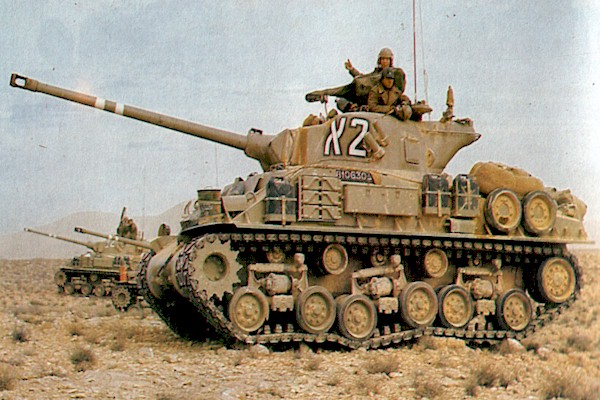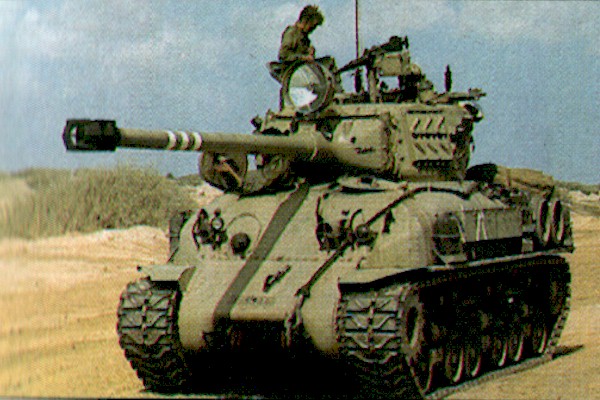An interesting read, thanks for the analysis.
Thanks also, MilesGregarious. An interesting and informative read.
Thanks.
When we take into consideration "sheer battle strength" of individual tanks, then tiger ii, pershing or is-2 come to mind (i voted tiger ii - pershing was probably better, but it saw action only in the very last days of ww2 and only in small numbers).
Both the Pershing and the IS-2 were far better than the Tiger II, which was mechanically unreliable in the extreme and so slow as to be nearly operationally irrelevant. The IS-2 actually contributed to the war effort, unlike the Tiger II.
and another issue is whether we take into account entire war (in such case it is obvious that tanks in 1945 were all better than tanks in 1939 or 1940) or how good a particular type of tank was in its time period (for example polish 7tp was used only in 1939 - but it was still not the best tank at that time).
If we go year by year, we get the Czech-built PzKpfw 38(t) or PzKpfw III in '39 and '40, the T-34 from '41 on.
Instead of devoting time and resources to develop prototypes and start production of these new tanks, they could have just concentrated on improving panzer iv and producing it - with some changes - until the end of ww2 in as large quantities as possible. Panzer iv was more cost-effective than heavy tanks such as tigers, because it was much cheaper and easier and faster in production. Tigers were produced in relatively small numbers.
If germans concentrated on producing only panzer ivs, maybe their tanks would not be so badly outnumbered in last years of ww2.
meanwhile ı would also be compelled to talk about Panther / Tiger combination ; their weight and cost and support requirements but they did hold the line in an extent PzKw IV could never hope to .
I fully accept the Panther as a valuable contributor to the German war effort, but the Tiger II contributed next to nothing. The Tiger I's contribution to/hindrance of the German war effort is debatable.
Without the obsession with supertanks (another of Hitler's contributions to the Allied war effort), the PzKpfw IV might have been upgraded with a redesigned sloped-armor superstructure. Whether this would have been effective enough or would have produced a significant increase in German tank numbers is unknown.
The Panther was probably worth it in the end, albeit overambitious and overengineered. The Tiger I might have been. The Tiger II was definitely a waste of resources.
because late versions of m4 sherman were indeed not much worse (if not equal or superior) than t-34/85. In many aspects it was better.
The final form of the Sherman, the M4A3E8(76)w, was equal to the T-34/85, and the two did square off in Korea.
The T-34 was a good tank, but I can't help but feel it's somewhat overrated - if you actually look at it's combat performance compared to German tanks, particularly Pz 3 and 4s as opposed to the later models, the T-34 really isn't amazing. Some of this is certainly due to the lower level of crew training and experience, but even later in the war when this factor was almost reversed with the Germans rushing crew in, the T-34 (including the 85 variant) still didn't perform that well.
Now certainly, when you look at the details of the tank like armour, weaponry and engine power, it looks very good compared to other vehicles of the same date. The problems were with less obvious features, such as the poor optics, lack of radios (some tanks had them but most were lacking) and 2 man turret (meaning that the commander had to spend time doing other jobs [firing the gun mainly], whereas the Germans had 3 man turrets - commander, loader, gunner) all of which meant that it was very difficult for the crew to take full advantage of it's capabilities due to the difficulties in maintaining situational awareness and coordinating with other friendly tanks.
Of course, when you have as many tanks as the Russians had, you can overcome such limitations.

I have never seen any evidence that the T-34 is overrated, or that anyone involved in combat with or against it ever argued with the conventional wisdom. The Germans were so shocked by it that they overreacted with temperamental revolutionary designs like the Panther and Tiger rather than slowly improving upon a tried and true platform in the Pz III/IV. The Soviets, who were obviously in the best position to judge, valued it highly enough to essentially discard the KV series in favor of concentrating on T-34 production.
It definitely had its shortcomings, but it can't be argued that the T-34 wasn't a war winner. The two-man turret (in which the TC
loaded, but didn't fire the main gun - minor point) was replaced by the three-man 85mm turret, and while early marks did indeed lack radios, that was a doctrinal, not a design, flaw. By mid-war, even T-34/76s with two-man turrets had radios. Early makes were also horribly unreliable (a ball-peen hammer being standard issue at times to
nudge recalcitrant transmissions into gear), but that was true of all Soviet AFVs of the era, not a flaw inherent in the T-34.
Any perceived failure of the T-34/85 must be attributed to external factors - a
highly skilled adversary with a particular adeptness at maximizing his advantages and an environment where the Germans had a plethora of light, man-portable AT weapons and the Soviets did not.
To add to MilesGregarious, the Tiger I and II had severe engine problems (they broke down, a lot) and mobility issues. They were heavy enough that they tore up most roads, had to avoid certain terrain and especially had to avoid many bridges that would've collapsed under their weight. IIRC, at least one of the variants had a snorkel system to let them drive through a river, however that took something like an hour to set up. Plus, lol, who the hell would want to trust a notoriously break-down prone vehicle to cross a wide river? I sure wouldn't, that is practically asking to die. I don't think the snorkel was ever used much, now that I think about it.
They were also large enough that only dedicated recovery vehicles could tow them around. They'd basically take a special Tiger with a lifting arm out into the field to grab and move a broken vehicle. Given that they already couldn't produce enough of them, having to dedicate some production resources to a dedicated (and unarmed IIRC) recovery variant seems like a massive waste.
The Tiger, both marks, and the Panther both suffered from being too heavy for German material technology of the time. Both suffered from transmission failure due to their weight. In the case of the Panther and the Tiger I, these were eventually partially rectified, though never fully solved. Additionally, the interleaved road wheel system employed on both made for an overly complex manufacturing process and a maintenance nightmare. It's no accident that post-war tank design took little from either vehicle.
I'm going to vote for the T-34. I'm actually surprised to hear that the Sherman is held in such high esteem; I've only really heard bad things about it.
The Sherman gets a bad rap. Of its three primary faults - weak armament, tendency to burn, and weak armor – one was doctrinal, not technical (weak main armament), one was not unique to the Sherman, and was largely corrected in any event (flammability), and one was largely a matter of perception (armor protection).
The US Army’s Tank Destroyer Doctrine stipulated that tanks were
not to engage enemy armor, but leave it to tank destroyers to do so. This resulted in the Sherman being undergunned because the 75mm was chosen for its superior HE characteristics, ideal for the Shermans perceived role of engaging only soft targets. The Sherman was blessed, however, with a roomy enough turret and a wide enough turret ring to allow it to be comfortably and easily upgunned. Were it not for the obstinacy of the US Army brass the Sherman could have been wielding the 76mm gun much sooner. As a side benefit of being undergunned, 75mm Shermans, with their spacious turrets, could maintain a higher rate of fire than similarly armed vehicles.
The Sherman’s ability to take ever larger guns cannot be overstated. Not only did the standard Sherman design allow for the 76mm upgrade, it also gave birth to the Firefly with its 17-pdr and a 105mm-armed version, as well as taking the 90mm M36 Jackson turret when Jackson chassis proved to be in short supply. Post-war,
in Israeli hands, the Sherman was upgunned yet again, first with the high-velocity French CN 75-50, a development of the same gun used by the Panther, and later with the same 105mm (albeit cut down) used on the French AMX-30 Main Battle Tank!
75mm-armed M-50 Sherman
105mm-armed M-51 Sherman
The tendency to “brew up” was not unique to the Sherman. Native British and German designs also cooked off – some models in comparably bad numbers. Late model Shermans, starting with the M4A1(76)w (where ‘w’ stands for wet storage) encased spare ammo in sheaths containing a mix of water and antifreeze. The 105mm variant had armored storage boxes. Both methods significantly reduced the tendency for rounds to explode when the vehicle took damage.
The Sherman’s armor was actually not that bad, either. Whether by design or fortuitous happenstance, the Sherman had a fairly well sloped front armor plate – not as well sloped as a Panther or T-34, but much more so than a PzKpfw IV, a KV, a Crusader, a Churchill, or even a Tiger I. This gave the Sherman, frontally at least, fairly decent protection. The problem for the Sherman, and all US/UK vehicles, was that German AT weapons had far greater penetrative abilities than their Allied counterparts – with the exception of the 17-pdr and Russian 100mm D-10.
A final advantage of the Sherman, often forgotten (and often disused by crews in the field), was the gyrostabilizer (first installed on the M3 Lee!). A gyrostabilizer helped maintain the main gun at a constant level as the tank moved, allowing for more rapid target acquisition and more accurate fire while on the move. Unique to US AFVs (Take that, superior German engineering!), though not to the Sherman, gyrostabilization, when used - crews often disconnected them as they were complicated and many didn't like a heavy gun breech swinging around the turret with a mind of its own - they could provide a critical edge, especially to get off that all important first shot in a gun duel.
The Sherman definitely had its flaws. The men who served in them may have often longed for the protection afforded German tankers in their Panthers and Tigers, but to the generals directing armies, the bureaucrats overseeing production, and the mechanics keeping them running, the Sherman's flaws were more than compensated for by its strengths. As the adage goes, "Amateurs study tactics; professionals study logistics." The Sherman, whatever one makes of it tactically, was definitely a logistical heavy hitter.







